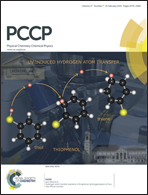Negative thermal quenching of photoluminescence in annealed ZnO–Al2O3 core–shell nanorods†
Abstract
ZnO–Al2O3 core–shell nanorods (NRs) have been fabricated through the vapor phase condensation method and atomic layer deposition. It is found that the nanorod comprises a wurtzite single crystalline ZnO core with the main axes along the [0001] direction and an amorphous Al2O3 shell. The temperature-dependent photoluminescence (PL) properties of the as-grown and annealed ZnO/Al2O3 NRs are investigated systematically. The PL of the as-grown ZnO/Al2O3 NRs demonstrates a normal thermal quenching feature. However, the salient behavior of negative thermal quenching (NTQ), i.e., the increase in PL intensity with an increase in temperature, is clearly observed in the annealed ZnO/Al2O3 NRs. A multi-level model is adopted to account for this behavior and the thermal activation energy of the NTQ process is estimated to be ∼69 meV. Moreover, we suggest that the activation energy is related to the Al donor defect in ZnO resulting from the inter-diffusion between the ZnO core and the Al2O3 shell during the annealing process.


 Please wait while we load your content...
Please wait while we load your content...